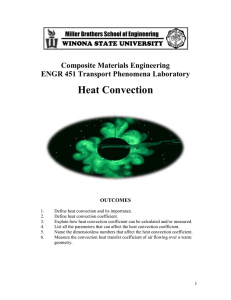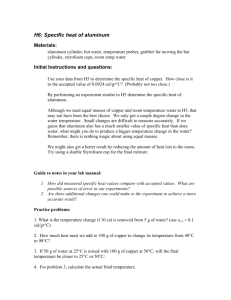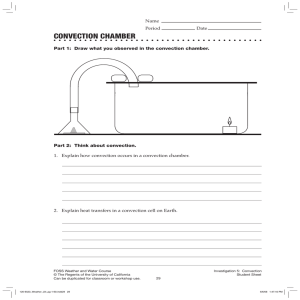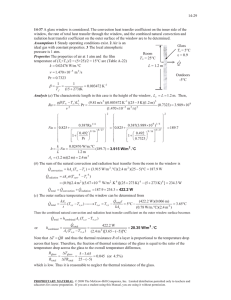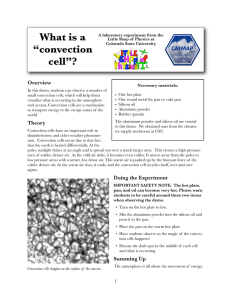International Journal of Application or Innovation in Engineering & Management... Web Site: www.ijaiem.org Email: Volume 5, Issue 4, April 2016
advertisement
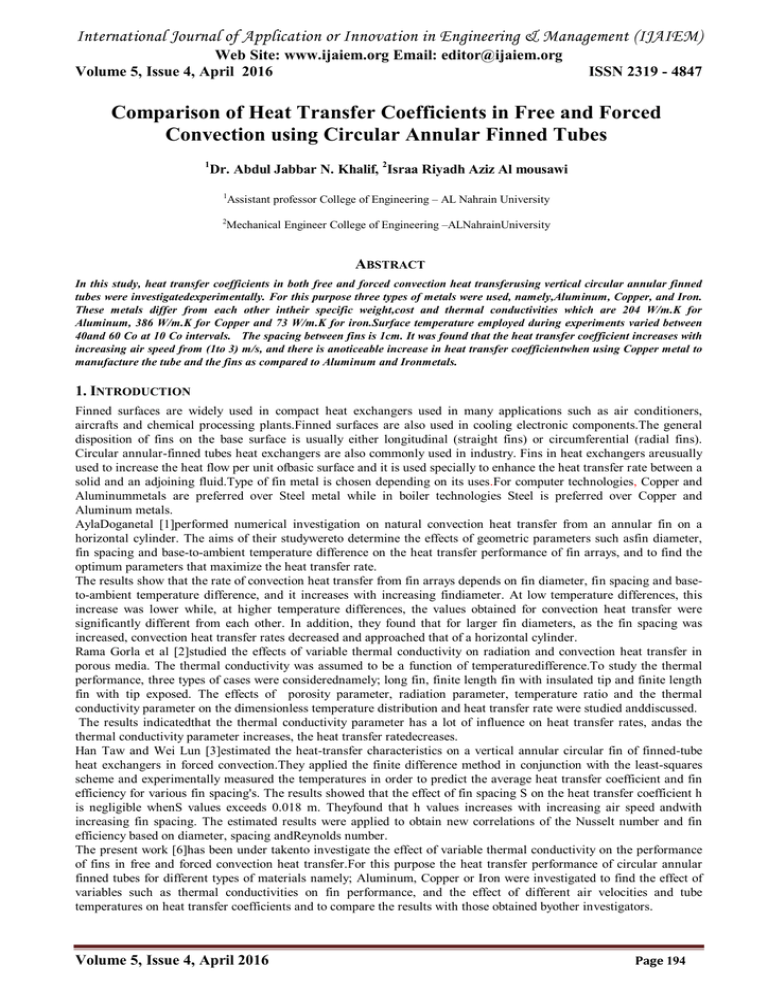
International Journal of Application or Innovation in Engineering & Management (IJAIEM) Web Site: www.ijaiem.org Email: editor@ijaiem.org Volume 5, Issue 4, April 2016 ISSN 2319 - 4847 Comparison of Heat Transfer Coefficients in Free and Forced Convection using Circular Annular Finned Tubes 1 Dr. Abdul Jabbar N. Khalif, 2Israa Riyadh Aziz Al mousawi 1 Assistant professor College of Engineering – AL Nahrain University 2 Mechanical Engineer College of Engineering –ALNahrainUniversity ABSTRACT In this study, heat transfer coefficients in both free and forced convection heat transferusing vertical circular annular finned tubes were investigatedexperimentally. For this purpose three types of metals were used, namely,Aluminum, Copper, and Iron. These metals differ from each other intheir specific weight,cost and thermal conductivities which are 204 W/m.K for Aluminum, 386 W/m.K for Copper and 73 W/m.K for iron.Surface temperature employed during experiments varied between 40and 60 Co at 10 Co intervals. The spacing between fins is 1cm. It was found that the heat transfer coefficient increases with increasing air speed from (1to 3) m/s, and there is anoticeable increase in heat transfer coefficientwhen using Copper metal to manufacture the tube and the fins as compared to Aluminum and Ironmetals. 1. INTRODUCTION Finned surfaces are widely used in compact heat exchangers used in many applications such as air conditioners, aircrafts and chemical processing plants.Finned surfaces are also used in cooling electronic components.The general disposition of fins on the base surface is usually either longitudinal (straight fins) or circumferential (radial fins). Circular annular-finned tubes heat exchangers are also commonly used in industry. Fins in heat exchangers areusually used to increase the heat flow per unit ofbasic surface and it is used specially to enhance the heat transfer rate between a solid and an adjoining fluid.Type of fin metal is chosen depending on its uses.For computer technologies, Copper and Aluminummetals are preferred over Steel metal while in boiler technologies Steel is preferred over Copper and Aluminum metals. AylaDoganetal [1]performed numerical investigation on natural convection heat transfer from an annular fin on a horizontal cylinder. The aims of their studywereto determine the effects of geometric parameters such asfin diameter, fin spacing and base-to-ambient temperature difference on the heat transfer performance of fin arrays, and to find the optimum parameters that maximize the heat transfer rate. The results show that the rate of convection heat transfer from fin arrays depends on fin diameter, fin spacing and baseto-ambient temperature difference, and it increases with increasing findiameter. At low temperature differences, this increase was lower while, at higher temperature differences, the values obtained for convection heat transfer were significantly different from each other. In addition, they found that for larger fin diameters, as the fin spacing was increased, convection heat transfer rates decreased and approached that of a horizontal cylinder. Rama Gorla et al [2]studied the effects of variable thermal conductivity on radiation and convection heat transfer in porous media. The thermal conductivity was assumed to be a function of temperaturedifference.To study the thermal performance, three types of cases were considerednamely; long fin, finite length fin with insulated tip and finite length fin with tip exposed. The effects of porosity parameter, radiation parameter, temperature ratio and the thermal conductivity parameter on the dimensionless temperature distribution and heat transfer rate were studied anddiscussed. The results indicatedthat the thermal conductivity parameter has a lot of influence on heat transfer rates, andas the thermal conductivity parameter increases, the heat transfer ratedecreases. Han Taw and Wei Lun [3]estimated the heat-transfer characteristics on a vertical annular circular fin of finned-tube heat exchangers in forced convection.They applied the finite difference method in conjunction with the least-squares scheme and experimentally measured the temperatures in order to predict the average heat transfer coefficient and fin efficiency for various fin spacing's. The results showed that the effect of fin spacing S on the heat transfer coefficient h is negligible whenS values exceeds 0.018 m. Theyfound that h values increases with increasing air speed andwith increasing fin spacing. The estimated results were applied to obtain new correlations of the Nusselt number and fin efficiency based on diameter, spacing andReynolds number. The present work [6]has been under takento investigate the effect of variable thermal conductivity on the performance of fins in free and forced convection heat transfer.For this purpose the heat transfer performance of circular annular finned tubes for different types of materials namely; Aluminum, Copper or Iron were investigated to find the effect of variables such as thermal conductivities on fin performance, and the effect of different air velocities and tube temperatures on heat transfer coefficients and to compare the results with those obtained byother investigators. Volume 5, Issue 4, April 2016 Page 194 International Journal of Application or Innovation in Engineering & Management (IJAIEM) Web Site: www.ijaiem.org Email: editor@ijaiem.org Volume 5, Issue 4, April 2016 ISSN 2319 - 4847 2. EXPERIMENTAL WORK The test rig used consists of air duct and control and display units. An assembly of vertical finned-tube were fixed into the air duct by a shaft and aligned vertically in the direction of gravity. The air duct has a transparent part (12cm×12cm) which makes the finned-tube visible.In order to calculate the heat transfer, thin thermocouples wires of 1.5mm outer diameter including fiber glass insulation of type K with welded tips were embedded into the vertical tube wall and top surface of the circular fins and adjusted to keep its tip at the surface of the tube and fin.The heater inserted in the vertical circular tube to act as heat source. The thermocouples were distributed on the fins and tube as can be seen in figure (1). Figure (1) Thermocouples locations The air flows from the inlet and drugged up by a fan to the outlet in case of forced convection and flows by the difference of air density in free convection. Heater wires were connected with the (Variac)volt meterto control the input voltage to the heater. Thermocouples were connected to digital temperature recorder to read the temperature of each thermocouple. The experiment was performed at different temperatures of heater (40, 50, and 60) °C. The voltage across the heater was measured by voltmeter and the resistance of the heater was calculated.The input power was estimated from the relation: Qtotal = ) The steady state was established after about half hour, then the readings of thermocouples and input power were recorded to study the steady state free and forced convection heat transfer subjected to constant heat flux boundary conditions. Natural convection phenomenon is characterized by dimensionless combinations named Rayleigh number which was studied with variation in Nusselt number to characterize natural convection. Reynolds number is a dimensionless quantitywhich is used to study forced convection heat transfer. 2.1 Heat transfer analysis: The power input to the heater is equal to the total heat transfer from vertical finned-tube to the surrounding at steady state condition. The net heat is transferred from a heated surface to its surrounding by both convection and radiation, Conduction and Radiation heat transfer were neglect here for their small quantities. 2.2 Convection heat transfer: Free convection heat transfer can be calculated from the equationbelow: Volume 5, Issue 4, April 2016 Page 195 International Journal of Application or Innovation in Engineering & Management (IJAIEM) Web Site: www.ijaiem.org Email: editor@ijaiem.org Volume 5, Issue 4, April 2016 Where represents the temperature of the tube, finned-tube arrangement, respectively, and ISSN 2319 - 4847 are the temperatures before and after vertical is the fin efficiency The equation above was derived from equation (4.5) individually [4]. 2.3 Calculation procedure: For free convection heat transfer, the physical properties of air are calculated at mean film temperature (average of tube temperature and surrounding temperature)[5]. The average Nusselt number has been calculated by: Where d is the outer diameter for tube (m), K represent the thermal conductivity of air at The average heat transfer coefficient has been calculated by: . The average Rayleigh number has been calculated by: For forced convection heat transfer the physical properties of air are calculated at film temperature (average of tube temperature and mean temperature). The mean temperature represent the temperature before and after the finned-tube and is calculated by: The average Nusselt number has been calculated by: Where d is the outer diameter for tube in (m), K represent the thermal conductivity of air at , h is the heat transfer coefficient (w/ K), The average heat transfer coefficient has been calculated by: The maximum Reynolds number has been calculated by: Volume 5, Issue 4, April 2016 Page 196 International Journal of Application or Innovation in Engineering & Management (IJAIEM) Web Site: www.ijaiem.org Email: editor@ijaiem.org Volume 5, Issue 4, April 2016 Where ρ represent density v is air speed (m/s), ISSN 2319 - 4847 is the hydraulic diameter = (4×area/circumferences) μ represent the viscosity ( Kg/m.s). 3.Result and discussion 3.1 Free Convection Heat Transfer from Aluminum, Copper and Iron Specimens. To measure the free convection heat transfer for Aluminum, Copper, and Iron finned tubes, a heater is used to furnish a power of about (2to 6.7) Wfor the tubes made from these metals. During the experiments, the voltage is maintained at constant level by controlling the Variacvoltage controller.During the experiment, it was noticed that the surface temperatures of Aluminum, Copper, and Iron finned tubes reached a steady state condition after about 45 to 50 minutes. The steady state temperature is recorded using digital temperature recorder. Figures (2), (3) and (4) show the variation of the temperature difference (∆T) between the tube surface temperature and surrounding air temperature, versus heat transfer coefficient (h) for Aluminum, Copper and Iron finned tubes. Fig (2) Variation of Average heat transfer coefficient in free convection for Aluminum with temperatures differences (Ttube –Tsurr) Fig (3) Variation of average heat transfer coefficient in free convection for Copper finned tubes with temperature difference (Ttube –Tsurr) Volume 5, Issue 4, April 2016 Page 197 International Journal of Application or Innovation in Engineering & Management (IJAIEM) Web Site: www.ijaiem.org Email: editor@ijaiem.org Volume 5, Issue 4, April 2016 ISSN 2319 - 4847 Fig (4) Variation of average heat transfer coefficient in free convection for Iron finned tubes with temperature difference (Ttube-Tsurr) The results indicate, in general, that the average heat transfer coefficients for the three tested metal samples increase with increasing the temperature difference between the tube and the surrounding air temperatures. This is because the buoyancy induced flow is more effective in free convection and as a result of this, the heat removed by cold fluid from the ambient surrounding increases. This results in an increase heat transfer coefficient.This agreed with results reported byAylaDogan et al [1]. In addition, due to increase in the thermal boundary layer thickness along the tube, the surface temperature increases. The increase in both temperature difference and heat transfer coefficient is also due to the increase in heat input which is appliedgradually. It can be observed that the highest value of (h) is attained when the fins are made from Copper metals as compared to Aluminum and Iron metals. Figures (5), (6), and (7) show the effect of Rayleigh number Ra on the Nusselt number Nu for the three materials. Nusselt number Nu is taken as Nu=h* where D represent the outer diameter of the vertical tube, K is the thermal conductivity of air, h is theheat transfer coefficient, Rayleigh number Ra is taken as Ra=Gr*Pr where Gr is equal to: and S represent the effect of spacing on Grashhofnumber which matches the results reported byHan-Taw Chen et al [3].The Nusselt and Rayleigh numbers were found to depend on the physical properties of the air at film temperatures. It was alsofound that when heat input increases, the physical properties of both Nusselt and Rayleigh numbers increases for each test. Fig (5) Rayleigh numbers Ra versus Nusselt number Nu in free convection for Aluminum Volume 5, Issue 4, April 2016 Page 198 International Journal of Application or Innovation in Engineering & Management (IJAIEM) Web Site: www.ijaiem.org Email: editor@ijaiem.org Volume 5, Issue 4, April 2016 ISSN 2319 - 4847 Fig (6) Rayleigh numbers Ra versus Nusselt number Nu in free convection for Copper with Fig (7) Rayleigh numbers Ra versus Nusselt number Nu in free convection for Iron with The results show that, the highest values of Nusselt and Rayleigh numbers are for Copper thereafter for Aluminum and then for Iron. A sample of the correlations obtained between average Nusselt number and average Rayleigh number canbe given as: 3.2 Forced Convection Heat Transfer from Aluminum, Copper and Iron Specimens. Specimens of Aluminum, Copper and Iron finned tubes were testedunder forced convection heat transfer. A variable power of about (2-18) W was supplied to the specimens by a heater. Thevoltage is maintained at a constant levelusing the Variacvoltagecontroller. The surface temperature of finned tubesreached a steady state condition after around (4550) minutes. The experiments were performed on three different inlet air velocities; namely (1, 2, and 3) m/s. Figures (8) to (16) illustrate the variation between the average heat transfer coefficient and temperature differences ( - in Aluminum, Copper, and Iron finned tubes. Fig (8) Variation of heat transfer coefficient with temperature difference for Aluminum metal finned tubes and velocity of 1m/s Volume 5, Issue 4, April 2016 Page 199 International Journal of Application or Innovation in Engineering & Management (IJAIEM) Web Site: www.ijaiem.org Email: editor@ijaiem.org Volume 5, Issue 4, April 2016 ISSN 2319 - 4847 Fig (9) variation of heat transfer coefficient with temperature difference for Aluminum metal and velocity of 2m/s Fig (10) Variation of heat transfer coefficient with temperature difference for Aluminum metal finned tubes and velocity of 3m/s Fig (11) Variation of heat transfer coefficient with temperature difference for Copper metal finned tubes and velocity of 1m/s Volume 5, Issue 4, April 2016 Page 200 International Journal of Application or Innovation in Engineering & Management (IJAIEM) Web Site: www.ijaiem.org Email: editor@ijaiem.org Volume 5, Issue 4, April 2016 ISSN 2319 - 4847 Fig (12) Variation of heat transfer coefficient with temperature difference for Copper metal finned tubes and velocity of 2m/s Fig (13) Variation of heat transfer coefficient with temperature difference for Copper metal finned tubes and velocity of 3 m/s Fig (14) Variation of heat transfer coefficient with temperature difference for Iron metal finned tubes and velocity of 1 m/s Volume 5, Issue 4, April 2016 Page 201 International Journal of Application or Innovation in Engineering & Management (IJAIEM) Web Site: www.ijaiem.org Email: editor@ijaiem.org Volume 5, Issue 4, April 2016 ISSN 2319 - 4847 Fig (15) Variation of heat transfer coefficient with temperature difference for Ironmetal finned tubes and velocity of 2 m/s Fig (16) Variation of heat transfer coefficient with temperature difference for Iron metal finned tubes and velocity of 3 m/s Figures (8) to (16) illustrate the effect of temperature difference on the average heat transfer coefficient for all metals investigated. The average heat transfer coefficient for these three metals is found to increases as the temperature difference increases.For example when the values of ∆T are between 4≤ ∆T ≤ 13, h values are between 19.4≤ h ≤ 21.14. To study the effect of velocity on Nessult number,the relation between average Reynold numbers versus average Nessult numbers are drawn in Figures (17) to (22). In these figures, the vertical ordinate representsaverage Nessult number while the horizontal ordinate represents the average Reynold number. Fig (17) variation of Reynolds numbers versus Nessult number for Aluminum spacing 1cm with (40, 50, 60)°C temperatures Volume 5, Issue 4, April 2016 Page 202 International Journal of Application or Innovation in Engineering & Management (IJAIEM) Web Site: www.ijaiem.org Email: editor@ijaiem.org Volume 5, Issue 4, April 2016 ISSN 2319 - 4847 Fig (18) variation of Reynolds numbers versus Nessult number for Copper spacing 1cm with (40, 50, 60)°C temperatures Fig (19) variation of Reynolds numbers versus Nessult number for Iron spacing 1cm with (40, 50, 60)°C temperatures It is found that when the inlet air temperature is kept constant, the average Nu number increases with increasing Re number. It can be also observed that the highest average Nu number is for Copper metal than for Aluminum and Iron metals. This is because Copper metal possesses larger thermal conductivity compared to Aluminum and Iron metals 4.Conclusions 1. For free convection heat transfer, the heat transfer coefficient was found to increase as the temperature difference between the tube surface and the surrounding air temperature increases. For Aluminum, Copper, and Iron metals the percentage increase in heat transfer coefficients are approximately 26% 37%and 25% respectively when the temperature difference between the tube surface and the surrounding air is increased from 5ο C to 20ο C. 2. For forced convection heat transfer, the heat transfer coefficient was also found to increase as the temperature difference between the tube surface and the surrounding air temperature increases. For Aluminum, Copper, and Iron metals the percentage increase in heat transfer coefficients with air velocity 1m/s, are approximately 21% 30%and 15% respectively. These percentages are for temperature differencebetween 5ο C to 20ο C. 3. It was found that the heat transfer coefficient in free convection for for Aluminum falls between (13-21) w/m2.K while for Copper falls between (16-12)w/m2.K and for iron it falls between (11-16)w/m2.K 4. The heat transfer coefficient in forced convection for Aluminum was found to fall between (59-64)w/m2.K and air velocity of 3 m/s. the corresponding values of heat transfer coefficient for Copper and Iron approximately falls between (60-65) w/m2.K and (55-60)w/m2.K respectively. 5. It was found that the use of Copper and Aluminum metals to manufacture the tube and fins are preferred relative to Iron metal in increasing the heat transfer coefficient at all tube surface temperatures investigated. This is related to the higher thermal conductivities which these materials possess, and their higher thermal resistance, lower material weight and corrosion resistance. Volume 5, Issue 4, April 2016 Page 203 International Journal of Application or Innovation in Engineering & Management (IJAIEM) Web Site: www.ijaiem.org Email: editor@ijaiem.org Volume 5, Issue 4, April 2016 ISSN 2319 - 4847 References [1]. AylaDogan, SinanAkkus and ŞenolBaskaya, Numerical analysisof natural convection heat transfer from annular fins on a horizontal cylinde, Thermal Science and Technology Issn (2012)1300-3615ISSN 1300-3615. [2]. Rama Subba Reddy Gorla, M.T. DarvishiandF. Khani, Effect of Variable Thermal Conductivity on Natural Convection and Radiation in Porous Fins,International American V-King Scientific Journal (2013) PP 79-85. [3]. Han Taw and Wei Lun, Estimation of heat-transfer characteristics on a vertical annular circular fin of finned-tube heat exchangers in forced convection, International Journal of Heat and Mass Transfer 51 (2008) 1920–1932. [4]. MiSandar Mon and Ulrich Gross, Numerical study of fin-spacing effects in annular-finned tube heat exchangers, International Journal of Heat and Mass Transfer 47 (2004) 1953–1964. [5]. YunusA.Cengel, Heat Transfer a Practical Approach, third ed. Mc-Graw Hill, 2004. [6]. Israa Riyadh Jawad, Free and Forced Convection On the Outer Surface Of Vertical Finned Tubes,2016. Volume 5, Issue 4, April 2016 Page 204
